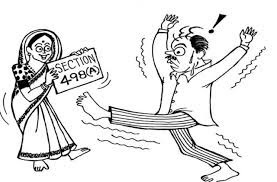Gender Neutral Laws for Sexual Offences
Two law students have filed a petition to the Supreme Court to have provisions in the Indian Penal Code relating to sexual offences against women reconsidered and amended to make them ‘gender-neutral. The petitioners have sought directions to reconsider the laws for offences against women under IPC including Sexual Harassment( 354A-354D) Rape( Sec 376) criminal intimidation (Sec 506) Insulting the modesty of women( Sec 509) and Cruelty to women (498A).
According to the petitioners, such laws are discriminatory on the basis of gender and have an impact on men’s basic right to equality, and thus violate Articles 14 and 15(1) of the Constitution. The petitioners contend in their plea that “fake feminism has contaminated the country.” Women purposefully assault men, destroying the dignity and respect of young boys who are forced to deal with pseudo feminists. Women have been handed a sharp-edged weapon like power by the law, without any reasonable restrictions.
WHAT IS GENDER NEUTRALITY?
To comprehend the aforementioned question, we must first understand the idea of “gender.” The term “gender” has generally been defined as a person who falls into one of two categories: male or female. This classification, however, excludes the “transgender” third gender, which includes the “hijras” and “kothis,” as well as communities where people are born with both female and male organs or communities that do not identify themselves as pertaining to any gender. Genders other than females who have been the victims of assault.
Various cases of assaults against the transgender communities of India have been reported. As a consequence, the present laws are discriminatory in that they only consider one facet of society, namely one gender, while neglecting the others.
The most disturbing aspect of their situation is that sexual violence is a very common occurrence against them. They are often assaulted for being transgender, and they are subjected to a lot of mental harassment in addition to physical violence. Being beaten up, having gobs of chemicals thrown at them to disfigure them, and other forms of physical abuse are all examples of physical violence.
When they report their cases of victimization to the police, some of them are also subjected to a lot of sexual abuse. The policemen try to humiliate them, accuse them of being victims, and even touch their body parts to make them feel uneasy and rape them. Whether or not physical violence is being used, this still amounts to harassment and must be taken into account.
Gender neutrality in sexual offence laws refers to the idea that rape victims and perpetrators can be anybody- men, women as well as transgender persons. It reflects modern understandings of the nature, effects and dynamics of non-consensual penetrative and non-penetrative sex acts.
IDEA OF MALE ON MALE RAPE
It is a brutal reality of the twenty-first century, that homosexuals have to undergo discrimination and persecution in this era, even after the Supreme Court’s decision that homosexuality is not a crime. In light of these shocking events, victims of sexual assault and rape are even more hesitant to contact the police or seek medical care, as they are afraid of how the authorities will react if they reveal that they are gay. This accurately portrays India’s socio-cultural fabric – a society that elevates males at the head of the household and prevents men from being recognized victims of sexual assaults. Being a homosexual is still taboo in our nation, despite the fact that many campaigners have battled for equal rights.
Since homosexuals are shunned by India’s typical communities, they often are prime prey for those who intend to assault them, as one can always blame the “gay man” for stepping forward and engaging in sexual activity with the assaulter. Male victims of rape and sexual assault have been unable to get the justice that demonstrates the inherent vulnerability and loophole in the legal system.
Under Chapter 8 Section 18(d) of the Transgender Persons (Protection of Rights) Act, 2019, whoever tends to act in a way that causes sexual abuse to a transgender person is punishable by imprisonment for a time of not less than six months but not more than two years, as well as a fine. This clearly demonstrates the legislature’s indifference to transsexual people. The stench of prejudice can be smelt because sexual abuse is classified as a minor offence punishable by a maximum of two years in prison and a fine, although a similar offence committed against a cis-gendered woman could result in a life sentence.
IDEA OF WOMEN ON WOMEN RAPE AND OTHER ASSAULT
Another facet that we overlook is the likelihood of women being perpetrators of violence towards other women. It could be that women are both victims and offenders. This dimension has never been explored, and the irony that there is no law holding women accountable adds to the misery of yet another form of assault on women.
The High Court of Madhya Pradesh stated in the case of State v. Sheodaya[1]l, that a woman’s modesty doesn’t need to be outraged by a man necessarily. Under section 354 of the IPC, it can be outraged by another woman too.
Another issue that emerged was whether or not women could be participating in gang rape. In the case of Priya Patel v. State of Madhya Pradesh[2], it was stated that there was a pre-requisite criterion in cases of gang rape that was “common intention.” There must be an intention to commit an assault or a rape act. Nonetheless, the court decided that a woman cannot possibly have committed such a crime. Despite widespread agitation and ramifications, this aspect of the case remains unclear, and experts are still trying to figure out how to answer the conundrum of whether or not women should be regarded as assaulters.
WHY LAWS SHOULD BE GENDER-NEUTRAL?
Indian society is primarily a patriarchal society, in which men are expected to behave in a specified manner, and any variation from this behaviour is met with derision from society – primarily other men. Some instances of how society expects an “ideal man” to act include the belief that a man cannot reveal his emotions or cry in public, that he must always be strong, and that a man must never complain of pain. This leads to gender inequality, which is why some men, even if they accept this, feel scared to speak about it.
The primary belief that women can never be offenders stems from the fact that, despite the fact that the definition of rape mentions multiple ways in which an action could be constituted rape, they would still be interpreted as penile-vaginal intercourse by the general public. This gives the general public the impression that only men can establish dominance since men are often built stronger than women in biological characteristics.
The second presumption stems from the idea that males can never be raped because they are excited by any sexual act, assuming that they have granted their consent. This is to imply that arousal in the male body can be produced only by the desire to be a willing participant. The stereotype that patriarchal societies hold about men is that they are presumed to be interested in sexual activity all the time, therefore eliminating the concept of consent in a sexual act.
Physiological variables are a big impediment in demonstrating sexual offence against a man. An engorged penis is thought to be proof of consent. This argument is as false as claiming that a woman agreed to a sexual act because her vagina lubricated during the act.
However, physiological responses to sexual stimuli, such as an erected penis or lubricated vagina, are out of a person’s control, and so are not evidence of conscious consent for the sexual act. Studies have shown that arousal can be produced by a variety of factors, including fear, embarrassment, and anxiety, all of which can lead to erections. There is now a growing acceptance of the notion that male exploitation does occur. There have also been a few developed countries, such as Canada, Finland, Australia, the Republic of Ireland, and the majority of the states in the United States of America, that have embraced gender-neutral laws.
In today’s world, the media plays a critical role in influencing public opinion. Men are rarely depicted as victims of sexual assault in mainstream Indian media, which presents an inaccurate view of the ideal man. The famous dialogue of the most famous Indian actor, saying that a real man feels no pain, is still the benchmark of manhood in the eyes of the public. Sexist humour and comedy are often used in Indian films to downplay the seriousness of sensitive issues such as patriarchy.
Another serious issue that the Indian media plays up is the comical stereotyping and presentation of homosexual and transgender characters. As a result, there is an urgent need to educate Indian society to embrace people of all genders and to question directors and filmmakers about stereotypical depictions of women and men, as well as the comic presentation of sensitive issues.
CONSTITUTIONAL PROVISIONS AND THEIR RELEVANCE
Part III of the Indian Constitution guarantees basic human rights to every citizen of India, irrespective of gender, and also provides for social justice in the Preamble. In the perspective of the law, Article 14 stipulates that everyone has the right to equality. This article asserts that everyone, regardless of gender, is equal. Article 15 prohibits differentiation on the basis of gender, i.e., no one can discriminate on the basis of a person’s or caste, sex, creed, or any other grounds of prejudice.
Regardless of the fact that male assaults are less common than female assaults, it is important to recognize that men cannot be exempted from the need for laws to protect them. Equal rights for men in cases of sexual assault does not imply that women’s rights are being taken away.
Giving men a platform, on the other hand, to voice out about their harassment and the right to file complaints would lessen the toxic masculinity of demonstrating supremacy, thereby minimizing assault on women, because the assertion of dominance has been the primary source of violence against women.
The fear of being judged by society and experiencing retaliation from a society that perpetuates the stereotype that “men cannot be victims of abuse” is one of the reasons why men do not speak up about being victims of sexual assault. Men themselves are under stress to have sex because of society’s preconceived notions about men and sex, as well as the fear that refusing to have intercourse would render them less of a man or make them appear gay.
They fear that opening up will only lead to them being labelled as “un-manly” or admonished that they are “not real men.” and that too, for the only reason that they were unable to embrace the sexual relationship that was offered to them by women. Likewise, the concept of a woman being the perpetrator of such crimes seems nonsensical, given the stereotype that women are the weaker sex who require protection.
It was in the 172nd Law Commission Report that the predicament of men was outlined in light of laws that are gender-centric and require considerate amendment, and later, in the Criminal Law (Amendment) Bill, 2012, it was suggested that the word “rape” be substituted by the word “sexual assault” wherever it occurs, to render the offence gender-neutral and to broaden the scope of the offence. Unfortunately, these recommendations went ignored.
CONCLUSION
Based on the preceding article and research, we can conclude that not only women, but also men and other gender identities, require assistance in cases of sexual assault. We should strive for equality in the law, and the existence of genders other than the two most frequently recognised genders cannot be disputed or ignored. Given that the law is nothing more than society’s collective will, the necessity to gender-sensitize the entire legal system and update appropriate mechanisms for investigating agencies is a sine qua non.
In order to develop an equal society, diversity and thoroughness must be fostered in both ideas and practice. Therefore, laws must be developed in a way to guarantee that criminals are held accountable regardless of the victim’s or accused’s sexual orientation. It is necessary to bring about holistic reforms in criminal law in order to make basic laws open to all victims, regardless of gender.
[1] 1956 CrLJ 83 M.P
[2] AIR 2006 SC 2639
About the Author

Anubhav seth
Student at Vivekananda School of Law and Legal Studies, VIPS.
He traces his academic roots from majoring in CBSE Class XII Commerce from Lancers Convent Senior Secondary School, Delhi. His areas of interest and research work are Constitutional Law, Criminal Law, Corporate Law, Intellectual Property Rights, and International Laws.
Previous Posts
Functioning of Copyright Board: Need of Export Advice in Digital Board
The era of Industry 4.0 and Gig Economy: The Future of Work and the New Labour and Industrial Regime





